Carbon
star -- see wikipedia definition

General
Properties of C stars (back to top)
 | The Catalogue of Galactic Carbon Stars,
version 3 (CGCS3): 6891 entries are present. A
suppliment catalogue is given for some addition notes on each object. (from
Alksnis et al., 2001BaltA..10....1A).
(Note, however, that the coordinates of stars with
RA(2000)>10h00m are wrong and the correct values
are given in Alksnis et al., 2001BaltA..10..461A.) |
Classes of C stars
(back to top)
 | Visual C stars:
(back to top)
 | ... |
|
 | Infrared
C stars: (back to top)
 | Infrared C stars (IRCSs)
are a group of AGB stars showing recognizeable SiC emission feature at
11.2um. (see Chan & Kwok, 1990A&A...237..354C) |
 | They analyzed ISO SWS spectra of 29 C stars with SiC emission feature at 11.2um.
They divided the sources into four groups: A, B, C
and D, with sequentially redder IR
colors and perhaps higher C/O ratios. They
found two new unidentified spectral features:
3.50 and 3.65um absorption. The other identified molecular bands
are:
2.48um, C2H2+CO, absorption,
2.58um, HCN+C2, absorption,
3.05um HCN+C2H2, absorption,
3.50um unidentified, absorption (new),
3.65um unidentified, absorption (new),
3.90um C2H2,
absorption,
5.20um C3,
absorption,
7.30um, C2H2(nu4,nu5)?,
absorption
11.30um SiC,
emission,
13.70um C2H2,
absorption.
They find that, on average, the relative integrated flux of the
3.05 um HCN+C2H2 absorption feature increases gradually from group A to B and C; that of the
5.20 um C3 absorption becomes gradually weaker from group A to B and C; that of the
11.30 um SiC emission increases gradually from group A to B and C but weakens in group D; and in contrast, that of the
13.70 um C2H2 absorption is gradually weakened from group A to B and C but enhanced in group D.
(from Yang et al., 2004A&A...414.1049Y)
(figs: (First row) Spectra
of group A, B, C and D from left to right;
(Second row) left -- nornalized profiles of 3.05um HCN+C2H2 feature; middle -- normalized
profiles of 3.50 and 3.65um unidentified features; right -- normalized
profiles of 13.7um C2H2 absorption feature;
(Third row) left 4 figs -- integrated line strength vs. line depth for 5, 3, 11
and 13um features; right most -- line center position vs. line depth of 11um SiC
feature;
(Bottom row) left 2 figs -- integrated line strength vs. Tnir; right 3 figs -- 11um
vs. 3um, 11um vs. 13um, 13um vs. 3um plots)
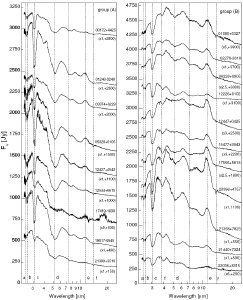 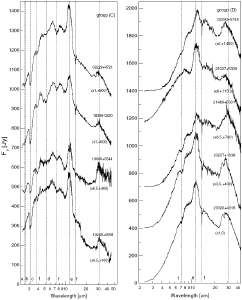
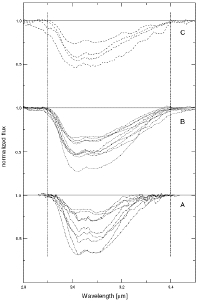 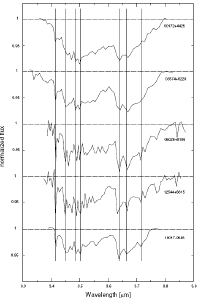
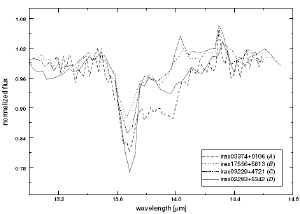
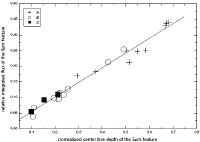 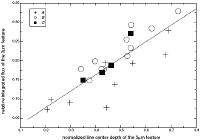
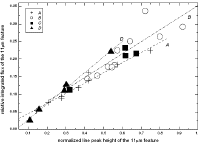 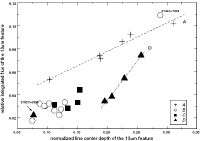
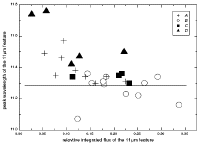
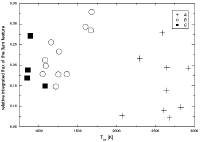 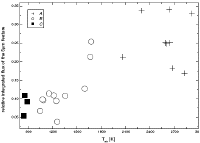
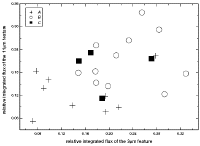 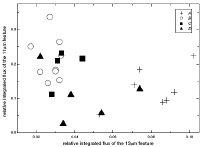
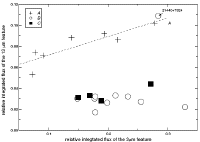 |
 | They collected all 349
infrared C stars known to date, found that the NIR (2MASS) and FIR
(IRAS) colors of IRCSs are in between that
of visual C stars and extreme C stars. The ISO spectra show that when
the SED of IRCSs becomes redder, the HCN+C2H2 absorption at 3.05um weakens gradually,
while the SiC emission at 11.2um and the C2H2
absorption at 13.7um enhance gradually. (from Chen & Shan,
2008Ap&SS.314..291C)
(figs: left -- IRAS color
diagram of visual, IR and extreme C stars; right -- 2MASS color diagram of the same sample of C stars.)
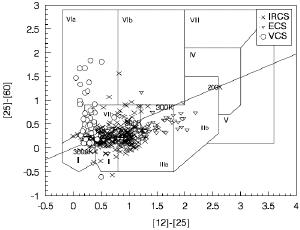 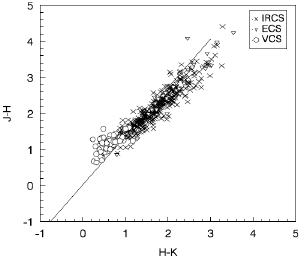 |
|
 | Extreme C stars:
(back to top)
 | Extreme C stars (ECSs)
are a group of coolest carbon stars with following characteristics
in their IRAS LRS spectra: (1) relatively flat
continuum between 7-23 um; (2) no
recgnizable dust emission feature or only weak SiC emission; (3)
a downturn towards shorter wavelength than
8 um (see in Volk et al., 1992ApJ...391..285V).
The carbon nature of ECSs is in accord with the strong CO and HCN lines
detected in them (Volk et al., 2000ApJ...530..408V). |
 | They collected 55
extreme carbon stars (ECSs) known to date (however,
they didn't mention their criteria for the selection of ECSs).
Then found that ECSs have much redder colors than ordinary visual C
stars. The ECS samples have mainly two types of IRAS LRS spectra: C and U, with U-type ECSs redder than C-type. The distributions
of both NIR and FIR colors roughly follow the blackbody line. (from Chen
& Shan, 2007Ap&SS.312...85C)
(figs: left -- IRAS color
diagram of visual C stars (crosses, for comparison) and extreme C stars
of LRS type C (dots) and U (circles); right -- 2MASS color diagram of the same sample of C stars.)
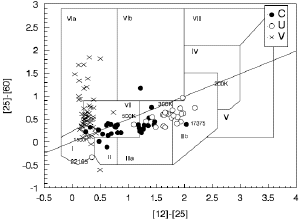 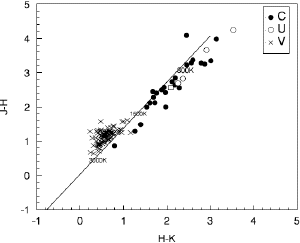 |
|
 | J-type C
stars: (back to top)
 | Characteristics of
J-type C stars: (1) over abundant 13C determined from optical
lines (13CN, etc.): 12C/13C < 15; (2) lack of s-processes elements (e.g., Tc); (3) more
than 75% of them have enhanced Li
abundance; (4) they are solar metallicity
stars; (5) possibly most of them are irregular or
semi-regular variables; (6) CSE of
J-type C stars are on average thinner than
that of ordinary visual C stars. |
 | Up to 2007, totally 113
J-type carbon stars can be found in literature. 66 of them have
IRAS LRS spectra. 13 ones of these 66 are silicate carbon stars (one with U type and 12
with E type of LRS spectra). They found that their NIR (2MASS JHK)
colors are similar to that of ordinary visual C stars. In the FIR (IRAS 12, 25,
60um) color domain, the J-type stars can be roughly into two groups: red
group below black body line and vertical group above the black body line
in the [12-25]-[25-60] diagram. The red group is mainly silicate carbon
stars while the verticle group is mainly visual carbon stars. (Q: How
were the 12C/13C ratio and s-process element abundances measured in the
red group stars? They are invisible!) (from Chen
et al., 2007AJ....134..214C)
(figs:
left --
IRAS color diagram of J-type C stars of various LRS types; middle -- 2MASS color
diagram of the same sample of C stars; right -- 2MASS color diagram of 80 visual C stars for
comparison.)
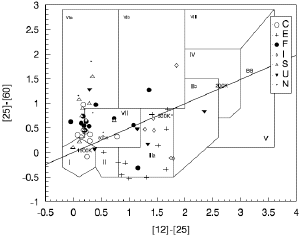 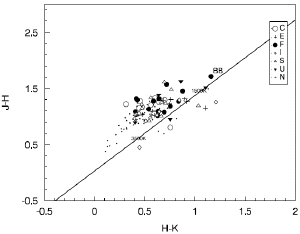 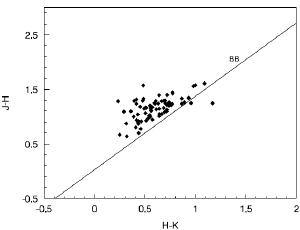 |
 | Possible explanation
of J-type C stars: for luminous stars, the hot bottom burning (HBB) can produce overabundance of 13C in the
surface; for less luminous stars, the semiconvection
may be at work. (Chan, 1993AJ....106.2126C) |
 | J-type C stars are believed to be binaries for which the
silicate
emission originates from a circumbinary or a circumcompanion
disc,
although not very sure. However, the connect between binarity and high
abundance of 13C is still unclear. |
 | It is known that most, if not all, silicate carbon stars are
J-type carbon stars, i.e. carbon stars with enhanced
13C and depletion of s-process elements. However, not all J-type carbon stars show silicate dust features.
(from Yamamura et al.,2000A&A...363..629Y) |
 | examples of J-type C stars:
 | IRAS 18006-3213. High spatial resolution interferometric VLTI/MIDI
observations in N band indicate that the most favourable model of
the dust geometry is a stable circumbinary
disk around the system,
seen under an intermediate inclination. The oxygen rich dust grains
are trapped in the disk. (Deroo et al., 2007A&A...467.1093D). |
|
|
 | Silicate
C stars: (back to top)
 | Silicate C stars are a small group of
stars showing both 11.2um carbonaceous dust
and 9.8 and 18um (oxygen-rich) silicate
dust features. Up to 2006, 35 silicate C stars
or candidates are known in total (Chen & Zhang, 2006ChJAA...6..697C),
plus one additional possible candicate (Chen & Wang, 2001ChJAA...1..344C).
Most silicate C stars are J-type C stars, but the
reverse is not true. |
 | Candidate explanations
of silicate C stars:
 | Scenario #1:
One oxygen and one carbon star in a binary
system (Little-Marenin, 1986ApJ...307L..15L).
However, no evidance of oxygen rich giant in silicate C stars were
found (Lambert et al., 1990AJ.....99.1612L;
Engels & Leinert, 1994A&A...282..858E). |
 | Scenario #2:
Transitional objects from oxygen rich
star to carbon rich star (Williems & de Jong, 1986ApJ...309L..39W;
Chan & Kwok, 1991ApJ...383..837C).
However, the transition time is theoretically short (several
decades, Evans, 1990MNRAS..243..336E), while some of them are found
to show C-rich photosphere over more then 50 years (Little-Marenin
et al., 1987LNP...291..396L)
and Yamamura et al. (2000A&A...363..629Y) found that the silicate carbon star V778
Cyg do not show temporal variation over 14 years after the IRAS LRS
observation. |
 | Scenario #3:
Low luminosity companion of a C star has stored the previously
ejected oxygen rich material in a circumbinary
disk (Morris, 1987PASP...99.1115M;
Evans, 1990MNRAS.243..336E)
or a disk around the companion (Yamamura et al., 2000A&A...363..629Y). There have been some observational
evidances supporting this idea: (1) Radial
velocity measurements of BM Gem and EU And are consistant with binary motion
(BarnBaum et al., 1991A&A...251...79B);
(2) Long-lived reservior of orbiting
gas was inferred from CO emission lines in BM
Gem and EU And by Kahane (1998ApJ...500..466K)
and Jura & Kahane (1999ApJ...521..302J)
respectively; (3) Violet spectrum of BM Gem support the presence of a low
luminosity companion with a circumstellar disk (Izumiura, 2003ASSL..283..189I);
(4) High spatial resolution mapping of
H2O masers in V778 Cyg by Szczerba et
al. (2006A&A...452..561S)
suggests the presence of a rotating disk around the secondary of a
binary; (5) High resolution mapping and
radiative transfer simulation of Hen 38
(=IRAS 08002-3803) by Ohnaka et al. (2006A&A...445.1015O)
suggests that the oxygen material is stored in a circumbinary disk. |
 | Scenario #4: A C star with O-rich
material stored in a circumbinary disk. They found very narrow CO lines (FWHM~1km/s) on the top of broad base (composite spectrum) in the silicate C star BM Gem.
The narrow component is interpreted as from a face-on circumbinary disk. (dist = 0.33-1.7 kpc)
(from Kahane et al., 1998ApJ...500..466K)
(fig: the composite CO 1-0 and
2-1 spectral line profiles.)
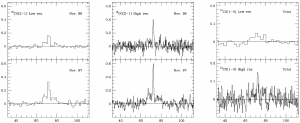 |
|
|
 | ... |
Other
Observations (back to top)
 | 23 new halo C stars were detected. All have
N-type spectra. Two of them are very distant: 95 and 110 kpc from the sun!!
(from Mauron et al., 2007, arXiv:0709.3000) |
Examples of C stars
(back to top)
- CRL 2688 (= EGG NEBULA) (with
shells in CSE) (Sahai 1998)->PPN
- IRAS 03229+4721 (= V384 Per = CIT 5 = IRC +50096 = RAFGL 489) -> C star studied by Herschel HIFISTARS.
- IRAS 09452+1330 (= IRC +10216 = CW Leo), with
arcs in CSE) ->PPN?
- IRAS 10131+3049 (= CIT 6 = IRC +30219 = AFGL 1403 = RW
LMi ) (an early stage AGB
star) -> C star studied by Herschel HIFISTARS.
- IRAS 10491-2059 (= V Hya = IRC -20218 = RAFGL 1439 = SAO 179278) -> C star studied by Herschel HIFISTARS.
- IRAS 12427+4542 (= Y Cvn = GSC 03459-02147 = HD 110914 = IRC +50219 = RAFGL 1576 = SAO 44317) -> C star studied by Herschel HIFISTARS.
- IRAS 15194-5115 (= II Lup) -> C star studied by Herschel HIFISTARS.
- IRAS 17150-3224 (with shells)
- IRAS 18476-0758 (= S Sct = HD 174325 = IRC -10467 = AFGL 2260) A carbon star showing double shell in CO line, studied by Herschel HIFISTARS
- IRAS 20396+4757 (= V Cyg = IRC +50338 = AFGL 2632) -> C star studied by Herschel HIFISTARS.
- IRAS 21358+7823 (= S Cep = IRC +80048 = RAFGL 2785 = SAO 10100) -> C star studied by Herschel HIFISTARS.
- IRAS 23166+1655 ( = AFGL 3068 = LL Peg ) (spiral pattern in
CSE)
- IRAS 23320+4316 (= LP And = IRC +40540 = RAFGL 3116) -> C star studied by Herschel HIFISTARS.
(back to top)
|
![]()